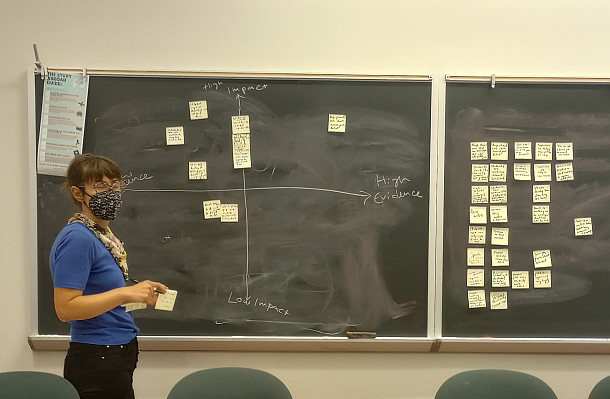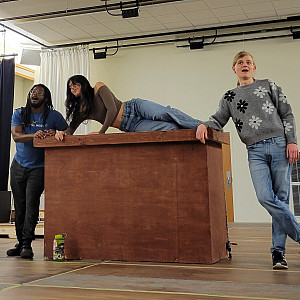Centering humans in design and the classroom
Executive-in-Residence Emily Eagle’06 is making a difference to the lives of students inside the classroom. Her experience as a design practitioner in the tech world brings a perspective to the Beloit College curriculum that students don’t always find otherwise.
Executive-in-Residence Emily Eagle is teaching a Topics in Visual Studies course, Human Centered Design Thinking, that brings students into the many frameworks and processes employed by designers and their collaborators to design products and experiences that serve human users.
The course has 17 students enrolled, coming from many areas of the college. Emily stresses that human centered design is inherently interdisciplinary and draws on many disciplines. Some students are majoring in things that an outsider might expect to align with design thinking, like Data Science & Analytics or Studio Art, and some students are majoring in less expected areas, like Japanese Language and Culture, Psychology, or Economics & Business. Some students, still exploring what Beloit has to offer, remain undecided. Emily has welcomed them all and the perspectives they bring to the class.
“A designer need not be an “artist”,” says Emily. “Design thinking practices, I believe, can help everyone learn and work together better.”

The class works with various tools that designers use in the field, from high-tech online interfaces to simple processes like post-it notes to service design diagrams. Through it all, Emily asks students to shift their perspectives to think of the varied humans who are the users. In one recent class assignment, students were challenged to consider the elements of good design by creating proposals for the “worst designed” products they could imagine. Submissions included a water fountain that required the user to put on a seatbelt in order to drink (from Mason Sorensen’25) and an electric kettle with a very tiny hole and a spout that turned around on itself making it difficult to get water in or out (from Yaksh Ujoodha’25). Students reviewed each other’s designs and voted with colorful stickers to find winners for several categories of “bad design” following a workshop method called “dot-voting” or “dot-mocracy.”

Ojaswi Dhakal’25 loves that the course emphasizes the importance of design. “Before this class, I thought design was limited to certain domains such as fashion and art,” she said. “Little did I think about how broad design is and how anything and everything is a design.”

No stranger to collaboration in the workplace, Emily is also working closely with Professor of Art George Williams, who is teaching a User Experience Design course this semester. “User experience design is a job that requires collaboration, and that’s true in Emily’s Human Centered Design Class, too,” said George. “Students get practice collaborating in her course, in a workshop environment. It’s been a good experience for the students.”
In addition to the class she is teaching, Emily has been contributing her skills to other courses as well. One such course is an upper level writing course that focuses on data analysis and communications, Writing Counting Seeing, taught by Professor of Modern Languages and Literatures Daniel Youd. In the course, students learn to analyze texts in novel ways, approaching books as datasets that can be studied with analytical and technical tools. As a guest speaker in the course, Emily Eagle led interactive sessions to have students consider how cultural expectations play into large language models, and how our own assumptions color the investigations we undertake.
Ali Hasnain ’25 recently described the Human Centered Design Thinking course and its methods as “the most liberal arts class possible” because it combines so many elements and really encourages students to participate. “It’s more like being in a meeting or a workshop than in a class.” Emily hopes that the exposure to these different frameworks will help the students consider their future impacts and careers from a human-centered perspective, whether or not they ever hold the title “designer.”




